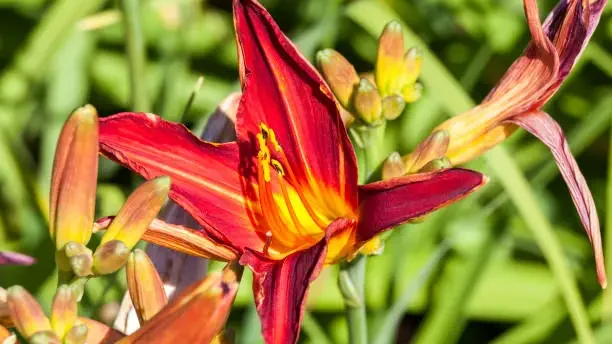Daylilies Deadheading – When and How Should You Do It?

Many horticulturists pick Daylilies because they easily conform to unfavorable and harsh climates. One thing familiar with daylilies is that they are sturdy and have no severe pest problems. When choosing where to plant them, choose carefully. Daylilies are large and can grow as large as 3ft in height.
What daylilies need to bloom properly is a warm shelter site. They also require plenty of water and fertile soil for them to thrive.
Even though daylilies can grow in poor soil with less fertilizer, they may not thrive. In such a case, use an organic soluble fertilizer to improve the ground’s fertility.
You can plant daylilies in pots and transplant them at the beginning of spring or toward the end of summer for beautiful blooms. The season daylilies bloom more towards the end of spring to autumn. Its flower can last for as long as 40 days or more.
Daylilies can produce up to a hundred blooms or more during their season. But the big question now is what to do after the daylilies bloom.
When to Deadhead Daylilies
Gardeners often ask questions like “is it possible to keep daylilies thriving”?
One way you can genuinely care for your daylilies after it blooms is through deadheading. When you deadhead daylilies, you’re indirectly assisting them to concentrate their energy more on making blooms rather than forming seeds.
Daylilies blooms are beautiful and an excellent choice for landscapes. Because of their minimal maintenance requirement, daylilies have become the most famous and favorite flower among gardeners.
But it helps to do some gardening work now and then to keep them beautiful. In doing so, you need to know when to deadhead the daylilies. Here are three periods when deadheading daylily is essential.
1. When it forms seeds pods
Daylilies are a type of flower that reproduce by sexual reproduction. In other words, daylilies produce seeds. To propagate daylilies, you can either plant seeds or divide new fans formed by each fan.
Most daylilies do not fertilize themselves, so pollination is a requirement to form fresh blooms. So, reproduction occurs when pollen grains are transferred from a daylily to another daylily’s pistil.
Many gardeners plant daylilies for their flowers and not for their seeds. However, please note that the daylily flower is a reproductive structure. The flower is sometimes called a blossom or bloom.
Daylilies flower form from a modified axis or shoot from an apical meristem of the flower. Daylilies that successfully pollinate form seed pods. We do not aim to produce the seed in this case.
When daylilies produce seeds, they spend their energy, time, and resources developing them rather than forming new flowers. Even though the bloom lasts only a day, thus its name, when the daylilies produce seed pods, it is a perfect time for deadheading. Seed production of daylilies takes away the potential for future flowering.
Deadheading daylilies are all about pruning the seed pod from the plant so it can focus its energy on producing new blooms.
When the pod starts to crack open at the top, it indicates it’s forming seeds. And when you peel open the pod, you’d see its shiny black tiny seeds within it. The seed pods are football-shaped and have a three-part seam along the top, which is straightforward to locate.
2. When you want to promote better bloom and growth
Another time we should deadhead daylilies is when we want to encourage their growth and bloom. As you already know, daylilies are flowering plant that produces seeds. Its seeds change from green to brown or yellow as it ripens. It may also interest you that it takes between 6 – 8 weeks to produce viable seeds, although it depends on some variables like the variety of daylily.
The idea of deadheading is the removal or pruning of seed pods and old blooms from the plant to promote more flower production. As we know, roots in plants are necessary and the primary route for the uptake of nutrients, even for daylilies. And the daylily is a type of plant that has only one source of nutrient uptake.
After taking up essential nutrients from the soil and combining it with photosynthesis, the flower will have all its needs to thrive. But when there is a breach in this balance, the daylily will not bloom or grow as it should.
For example, it wouldn’t bloom properly when the plant spends time producing seeds. If the plant also has so many faded leaves, it would obstruct its free flow of nutrients to needed areas in the plants for photosynthesis.
Remove old blooms from the plant to allow the free flow of air it needs to grow. When you remove all these things, your daylilies will be healthier. So, to ensure the daylilies bloom and develop well, deadheading is vital.
3. When it’s late fall or early spring
Another time you need to deadhead daylilies is during late fall or early spring. The simple reason behind deadheading daylilies during this period is that daylily is a seasonal flower. By this time, the daylilies would have completed their bloom cycle, making it the perfect time to deadhead. Deadheading is a bit tasking, but it would perform better after taking the time to do it.
If you’re a seasoned or new gardener and have a sunny location with rich, well-drained, damp to sandy soil, you’d enjoy planting daylilies. Daylilies require little attention and can grow even in extreme conditions.
Despite that, you should ensure the environmental conditions around which your daylilies grow is conducive for optimal blooming. And that is why you should deadhead your daylilies at the right time.
Daylilies come in different colors apart from pure white or blue colors. Some daylilies may even come in multiple colors and may produce double blooms. Some varieties of daylilies are fragrance, which attracts butterflies. The flowers of daylilies grow on stalks, while the entire flower stalk is the scape.
So, by deadheading daylilies during late autumn or the beginning of spring, you give them a better chance to bloom next season. It would be best if you deadheaded daylilies before winter because the plant is dormant. Further deadheading after this period might kill the plant.

How to Deadhead Daylilies
After flowering, the daylily will start to wither and becomes very unaesthetic and unattractive. At this point, you should deadhead a daylily to make it look aesthetic. Doing this also encourages a more extended flowering period and makes it look tidy. You can easily remove spent flowers with your hand.
When the flowers on a single scape bloom, prune it from the stalk of the daylily. You should remove the heads of the daylily’s seed and drain withered-looking leaves to make the daylily look healthy and encourage more bloom.
Now that you know how vital deadheading is to encourage more blooms in daylilies, which is what we all want, we also need to consider how to do it correctly. Indeed, deadheading daylilies make them look better and attractive, but doing it right is critical. Here are five ways to deadhead daylilies properly.
1. Leave the leaves
When daylilies bloom in a season, do not feel they will become useless. It might take a while, but under proper care, it will blossom again. And you can help it bloom again by leaving its foliage.
Cutting down the daylily’s leaves because you want to keep your garden neat weakens the daylily and reduces its chance of Taking caution during spring trim comeback. Why? Because the daylily leaves are responsible for photosynthesis and absorption of carbon dioxide – its primary carbon source.
The carbon and energy daylilies generate during photosynthesis are responsible for the buildup of its root. As soon as daylilies’ roots are strong enough, they will have a better chance of surviving the winter.
In other words, when you trim off daylilies foliage, it wouldn’t be able to bolster itself, which will result in producing weaker roots. The plant will also form a poorer flower next summer if it is not well-developed.
2. By cutting daylily flowers
Another way to deadhead daylilies is by removing their flowers. However, we are firmly against you cutting daylilies foliage. However, it is possible to prune the flower stalk of daylilies without affecting the plant.
As soon as the daylily’s bloom fades, you can cut it off from the flower stalk. As we mentioned earlier, there may be more than one bloom on a single stem. In this case, you should cut only the faded flower from the scape.
But if there is only one bloom on a single stalk, cut the faded flower down the stem about 3-4 inches close to the root.
Avoid cutting the blooms close to their roots, as it can pose disease threats to the flower or invite pests. If the stalk is left to keep growing season on the plant, it will develop into a viable seed. And this process requires so much energy from the plant. Rather than letting the daylily form blooms, it depletes the roots’ energy.
3. Light trims
Another way to deadhead daylilies is by light trimming, which involves trimming damaged leaves. Light trimming is quite tasking but very rewarding to daylilies as it helps them conserve energy. Light trimming also helps make it look more aesthetic. We mentioned earlier that you shouldn’t cut daylily leaves; however, cutting diseased and damaged-looking leaves is an exception.
You can trim off these exceptional leaves, but it has to be earlier in the season of daylilies so they can recover before winter. If only about 3-4 inches of the foliage is damaged, you can trim it. But if it is more than 3-4 inches, trim the entire foliage close to its root.
4. By transplanting trim
The best time for transplanting daylilies is towards the end of summer or autumn when most of the daylily’s blooms have already faded. Before transplanting the daylily, ensure you trim the leaves to about 6 or 8 inches long. Doing so makes working with daylilies easy, and, at the same time, it leaves enough leaves to produce energy for the roots.
Transplant trimming is a part of deadheading as it helps daylilies produce more bloom next season. After transplanting daylilies, it’s perfectly alright when you notice the leaves dying off. This process of the leaf dying off is called transplant shock. So, the best remedy is to give the daylily time and intensive care to recover independently.
5. Taking caution during spring trim
The shortcoming of trimming newly growing daylilies is that it grows from their center outward. So, transplanting or removing the central leaves that are newly forming will be a risk as it could damage the plant’s crown.
The damage doesn’t end there. It could also stunt the daylily’s growth. There’s also the risk of exposing its tissues to several pests and diseases.
If you’re planting daylilies in a wet spring area, this cut can put the daylilies at risk of fungal problems.